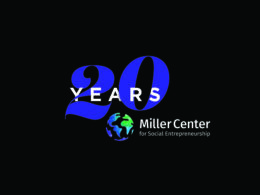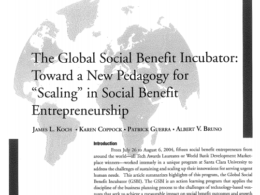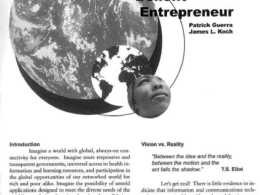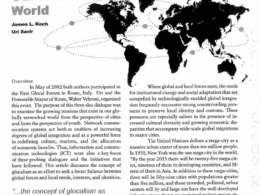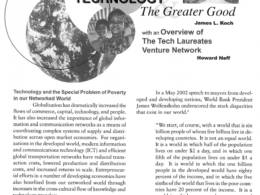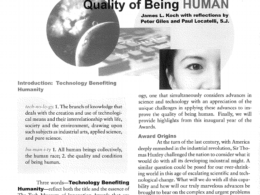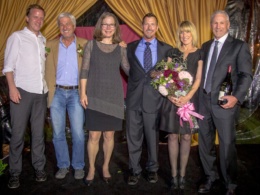OUR HISTORY

GSBI® programs evolved from the Center’s interest in the use of science and technology for social benefit[i]; its role in co-founding The Tech Awards; collaborations with the UN Millennium Project and their influence in defining The Tech Award categories to reflect urgent challenges and the Millennium Development Goals; and concerns about the barriers that innovators faced in scaling their social impact—especially in resource constrained environments[ii]. The GSBI in 2003 was developed during 2002 in collaboration with the Glocal Forum, a peace institute[iii] in Rome led by Uri Savir, the Chief Negotiator of the Oslo Accords with the Palestinians in 1993[iv]. As part of the University’s strategic plan under the direction of Don Dodson, Jim Koch, the founding Executive Director of CSTS, along with a Distinguished Board of Advisors and Father Locatelli crafted a Center and program rich with innovative thinking, thought leadership, and extraordinary global alliances[v].
In mid-2002, Patrick Guerra, a seasoned and successful early stage entrepreneur and business executive took a break from the commercial world and accepted the position of Executive Director for the Center for Innovation and Entrepreneurship (CIE) at Santa Clara University. Then, Leavey School of Business Dean, Barry Posner, challenged Pat to articulate a new vision and purpose for CIE: one that served students, engaged members of the faculty and attracted the attention of Business Leaders in Silicon Valley. Pat did extensive research on Innovation and Entrepreneurship and met with faculty across numerous disciplines. During a follow on meeting, Jim Koch introduced Pat to a problem that he had observed with both The Tech Awards and the Global Junior Challenge, a competition sponsored by the Glocal Forum and the Digital Youth Consortium in Rome. Jim Koch and the Center provided the judging for the Tech Awards and Jim was an advisor to the Glocal Forum. The Glocal Forum’s Global Junior Challenge sought to identify and recognize Information and Communication Technology (ICT) initiatives aimed at helping to bridge the digital divide.
Jim noted that several years after receiving the prestigious recognition from such competitions the “projects” being recognized showed little sign of extending their social benefit reach to those that could benefit from the product and service innovations. He asked Pat Guerra to think about what might be done to help these innovators and their organizations with both scaling beneficiary reach and obtaining the necessary financial resources to do so. In the course of Pat’s research on innovation and entrepreneurship, he was deeply influenced by the works of Gordon Bloom at Stanford, Gregory Dees at Duke, Jed Emerson at the Robert’s Enterprise Development Fund (REDF), the investment innovations at Pacific Community Ventures and the work of Bill Drayton, and his global Ashoka network. Bill had created Ashoka, in 1980 and coined the term Social Entrepreneur. To Bill, a Social Entrepreneur was society’s “change agent”.
The collaboration between CIE and the Center entailed utilizing the lessons of Silicon Valley to promote social justice, the mission at the heart of Jesuit education. It sought to engage the Valley’s creative energy, its products, services and business leaders in the challenges faced by the poor in resource-constrained environments. Dr. Albert Bruno, the William T. Cleary Professor of Marketing and Entrepreneurship and Founding Director of the CIE, had developed an extensive array of MBA level entrepreneurship curricula and case studies. Pat and Al set about adapting these materials to the needs of social mission entrepreneurs. This early work, and Al Bruno’s continuing instruction, still provide the foundational core of the program. The program, content, and faculty continue to learn, adapt, evolve, and refine the tools and instructional techniques. From the inception, Pat viewed the use information technology as an essential and integral element of the incubator, distance learning, collaboration, and mentoring. The GSBI continues to pilot various tools and platforms aimed at “distance incubation” and extending the reach of the program[vi].
Eric Carlson was appointed Associate Director of the GSBI in 2006 by GSBI Director Jim Koch. With Pat’s departure earlier that year, Jim coordinated a leadership team comprised of Eric, Al Bruno (Academic Dean), and Sherrill Dale (Program Manager) to finalize the selection process, design, and delivery of the 2006 GSBI program. Over the next seven years this team worked together to continuously strengthen the GSBI content, key processes and partner network. Within the GSBI leadership team, Jim focused on developing network partners, and Al guided the curriculum innovation process, while Eric and Sherrill assumed a major role in refining the application process. Eric engaged MBA students in the GSBI applicant vetting process and proposed new elements to the GSBI business planning paradigm based on alumni feedback, beginning with a module on Metrics in 2006.
Eric’s 2005 MBA Social Benefit Entrepreneurship class was the first course to be offered in social entrepreneurship at Santa Clara University. It provided the critical capacity needed for the growing number of online applications to the GSBI, and in 2006 students in his class were assigned to work with GSBI entrepreneurs in the refinement of their business plans. The syllabus for Eric’s course was eventually selected by Ashoka University as a model course for practical Social Entrepreneurship education. His pioneering MBA teaching served as a bridge to capture the lessons of the GSBI for current and future generations of students. In the same year that he launched his social entrepreneurship class, Jim offered the first section of Leadership for Justice and Prosperity—an MBA course to examine how the combination of technological and business model innovation could alleviate global poverty. Since 2005 Eric and Jim have collaborated in the development of pedagogical resources for the teaching of social entrepreneurship in the Leavey School of Business. Nearly 3,000 students have enrolled in their courses since Eric’s first offering in 2005, among them Cassandra Staff, Program Director for the GSBI.
With Al Bruno and Jim Koch providing academic leadership, Eric Carlson and Sherrill Dale became the operational drivers of the GSBI and, in many respects, its soul. They developed effective collaborations with a growing list of network partners and funders, including The Tech Museum of Innovation, Applied Materials, Noyce Foundation, Social Edge/Skoll Foundation, and World Bank Development Marketplace. When Jim Koch, was asked to serve as Acting Dean of the Engineering School at the start of 2007 Eric was appointed Acting Director of the GSBI. In 2008 the GSBI launched a “sector strategy” initiative with the initial focus on safe drinking water (lead by Jim Koch and Al Hammond) and a subsequent focus on off-grid energy (coordinated by Jim with Andy Lieberman). Andy Lieberman’s development of the Energy Map created a platform for examining the business models of more than 50 energy solutions for serving the poor around the world. During his GSBI leadership tenure, Eric worked with Sherrill Dale and Cassandra Staff to architect the GSBI online program and with Thane Kreiner (Executive Director) to secure a World Bank grant for the successful launch of this program. When Eric and Sherrill moved on, in 2013 and 2012 respectively, they left a strong core team that included Cassandra Staff, Andy Lieberman, an effectively integrated Lead Mentor role and the legacy of well-honed processes for guiding the work of a growing number of dedicated Silicon Valley mentors–the secret sauce of the GSBI. The formalization of these operating routines and growing international reputation of the GSBI enabled Jim Koch to focus on socializing the notion of a Jesuit /Catholic higher education network for advancing social entrepreneurship through presentations at Fordham University, Esade in Spain, Tech de Monterrey in Mexico, Fu Jen in Taiwan, XLRI in India, Atenea de Manila in Philippines and, with Thane Kreiner, at the 17th IAJBS World Forum in Peru.
Prior to his engagement in the GSBI Eric served as Editor of the STS Nexus. In this role he had overseen nearly thirty articles on the recipients of the Tech Museum Awards—a program co-founded by the Center for Science, Technology, and Society with the Tech Museum and Applied Materials. Much like Pat Guerra, Jim Koch, and Al Bruno—Eric had wondered aloud how Tech Laureates might use their significant cash awards to increase their impact and become sustainable ventures. In 2016, when the Tech Awards celebrated their 15th Anniversary, four of the six Laureates recognized as having the greatest impact over the fifteen year history of the awards were graduates of the GSBI.
The Center for Science, Technology and Society would like to thank Pat for his visionary leadership in creating a transformational program for social entrepreneurs. The collaboration with Jim Koch, and the esteemed global network of partners that Jim built in his role as Executive Director of the Center, and the innovative curricula contributed by Al Bruno made it possible to turn the vision into reality for social good.
Cynthia Graebe of SCU provided extraordinary love, care and program administration during the first year launch. A talented staff, students, and the generous support of insightful Silicon Valley executives, philanthropists and venture capitalists have continued to innovate and scale the program, and provide an unparalleled learning and networking experience. Building on the early foundation, additional global partnerships that developed include some of the leading organizations in the field. Pat has continued his poverty alleviation pursuits with organizations such as Ashoka, the Aspen Network of Development Entrepreneurs, IDEO, Acumen, the Rockefeller Foundation, Civic Ventures, the Second Harvest Food Bank, and the Media Policy Center. The origins of this work are important to understanding the early history of GSBI programs. The modular structure has facilitated the continuous innovation of colleagues, the engagement of network partners, and the ability to tap the work of thought leaders and leading edge practices in social entrepreneurship. Its innovative use of technology to benefit humanity is in many respects a hallmark example of the founding spirit of the Center for Science, Technology, and Society and the foundational work of the University planning process that sought to integrate the distinct institutional values of Santa Clara University with the palpable energy and innovation that characterizes Silicon Valley.
Cynthia Graebe of SCU provided extraordinary love, care and program administration during the first year launch. A talented staff, students, and the generous support of insightful Silicon Valley executives, philanthropists and venture capitalists have continued to innovate and scale the program, and provide an unparalleled learning and networking experience. Building on the early foundation, additional global partnerships that developed include some of the leading organizations in the field. Pat has continued his poverty alleviation pursuits with organizations such as Ashoka, the Aspen Network of Development Entrepreneurs, IDEO, Acumen, the Rockefeller Foundation, Civic Ventures, the Second Harvest Food Bank, and the Media Policy Center. The origins of this work are important to understanding the early history of GSBI programs. The modular structure has facilitated the continuous innovation of colleagues, the engagement of network partners, and the ability to tap the work of thought leaders and leading edge practices in social entrepreneurship. Its innovative use of technology to benefit humanity is in many respects a hallmark example of the founding spirit of the Center for Science, Technology, and Society and the foundational work of the University planning process that sought to integrate the distinct institutional values of Santa Clara University with the palpable energy and innovation that characterizes Silicon Valley.
[i] Technology and the Quality of Being Human, by Jim Koch, Paul Locatelli, S.J., and Peter Giles, STS Nexus, Fall 2001, Volume 2, Number 1, pages 4-9
[ii] Making the Circle Bigger—Technology and the Greater Good, by James L. Koch with Howard Neff, STS Nexus, Fall 2002, Volume 3, Number 1, pages 6-13.
[iii] The Glocal Forum focused on the relationship between poverty and peace. It placed a particular emphasis on youth in conflict regions and the need for achieving a better balance between globalization and community needs in the context of unprecedented urban migrations.
[iv] Glocalism and Our Networked World, by James L. Koch and Uri Savir, STS Nexus, Summer 2003, Volume 3, Number 2, pages 5-6.
[v] “Going to Scale” and the Social Benefit Entrepreneur, by Pat Guerra and Jim Koch, STS Nexus, Fall 2003, Vol. 4, Number 1, pages 7-15. It was planned to coincide with a major conference sponsored by the Center, Networked World: Information Technology and Globalization.
[vi] The Global Social Benefit Incubator: Toward a New Pedagogy for “Scaling” in Social Benefit Entrepreneurship, by James Koch, Karen Coppock, Patrick Geurra, and Albert Bruno, STS Nexus, Fall 2004, Volume 5, Number 1, pages 44-50.


